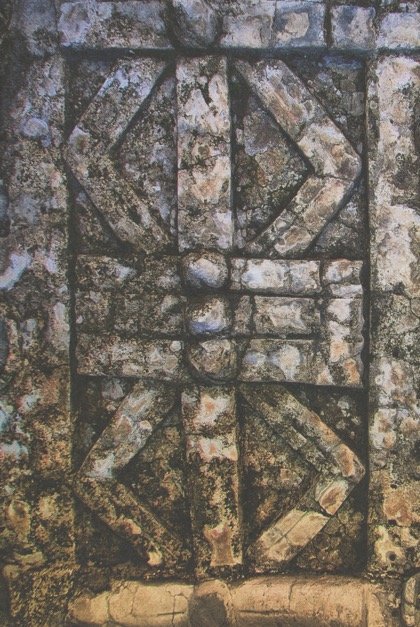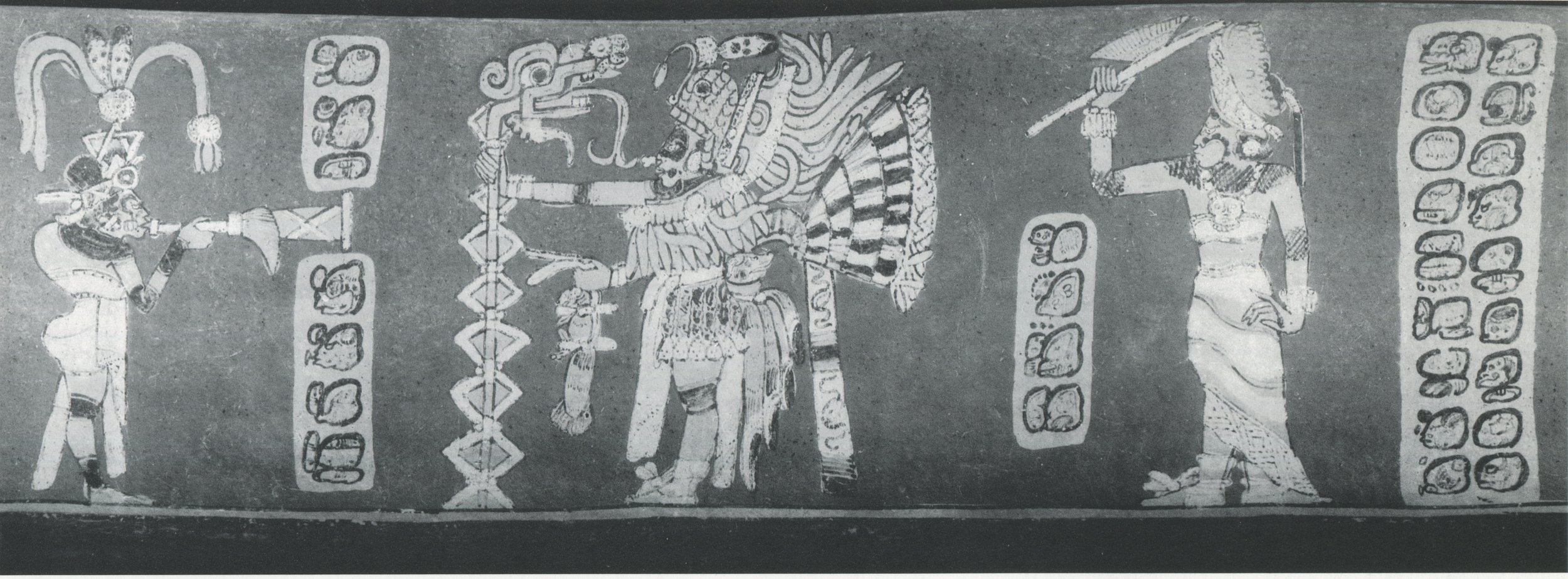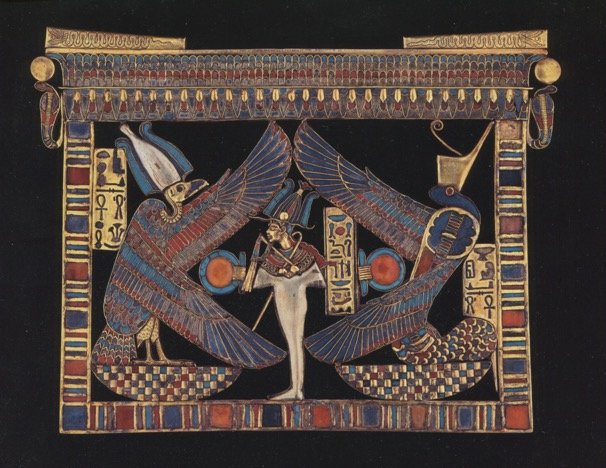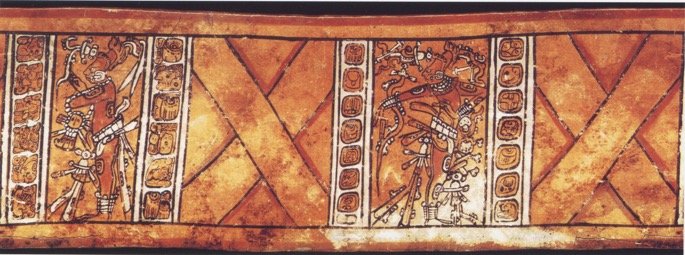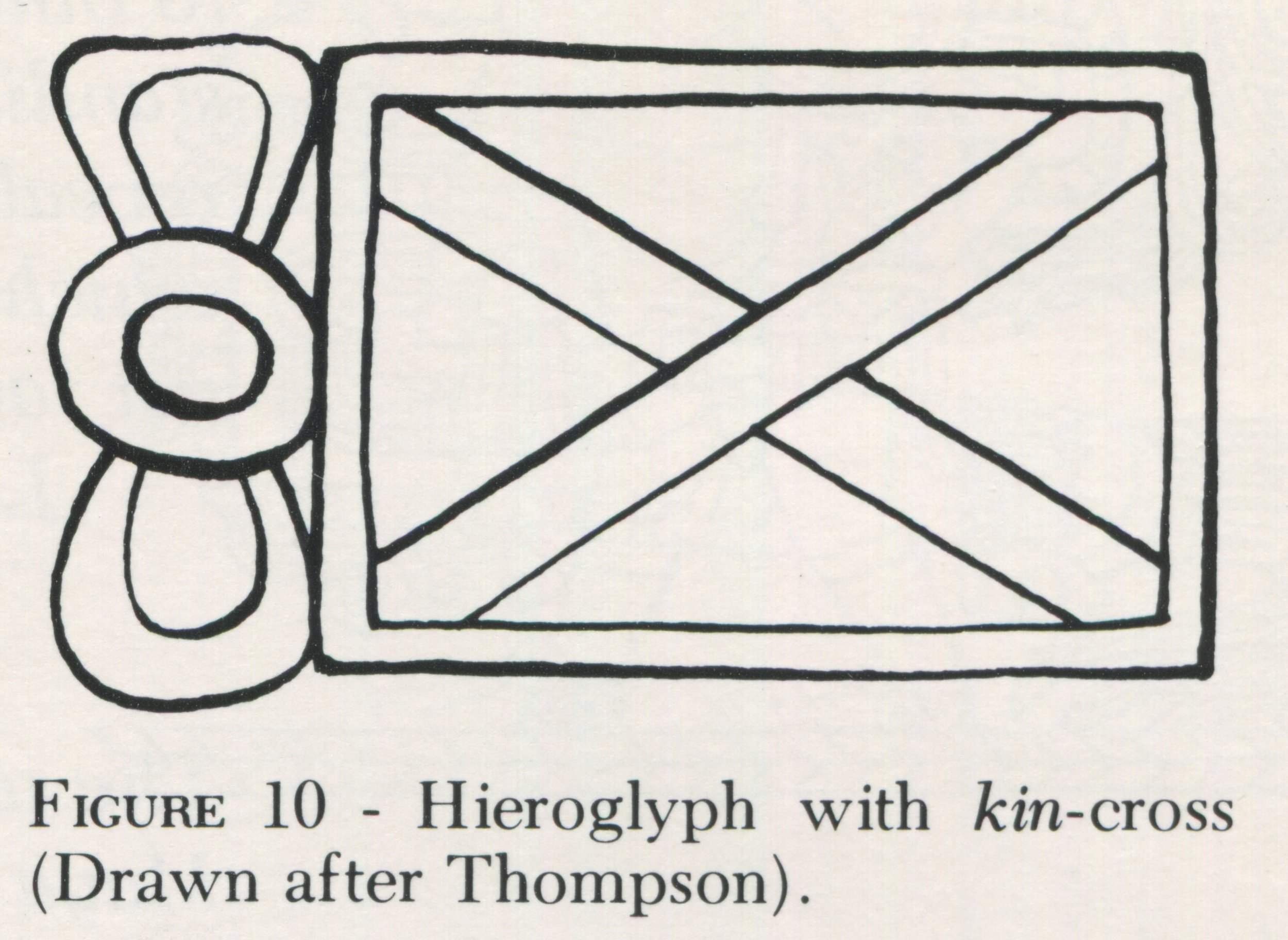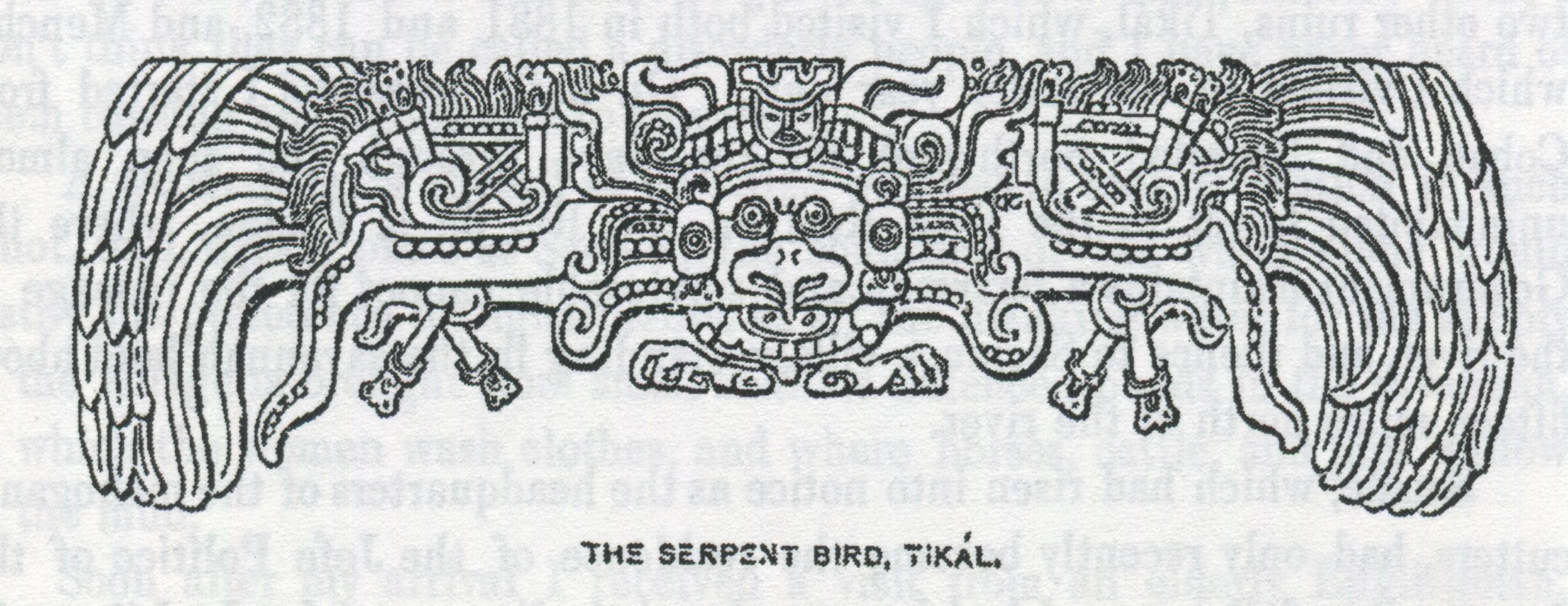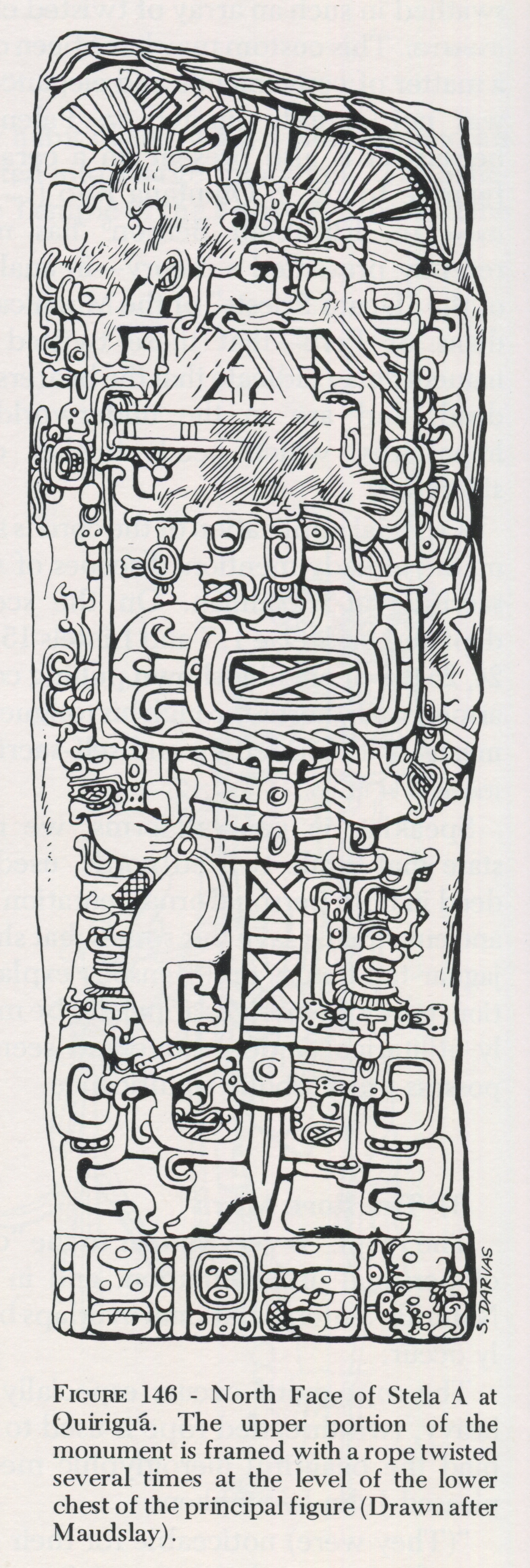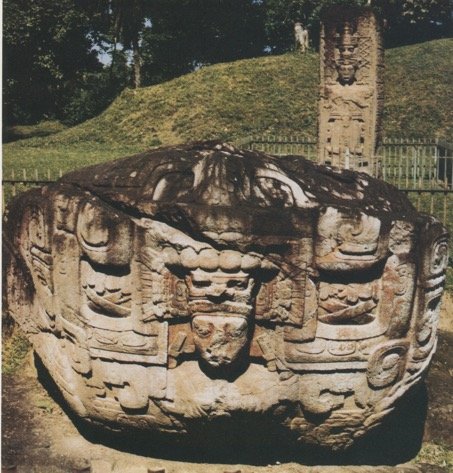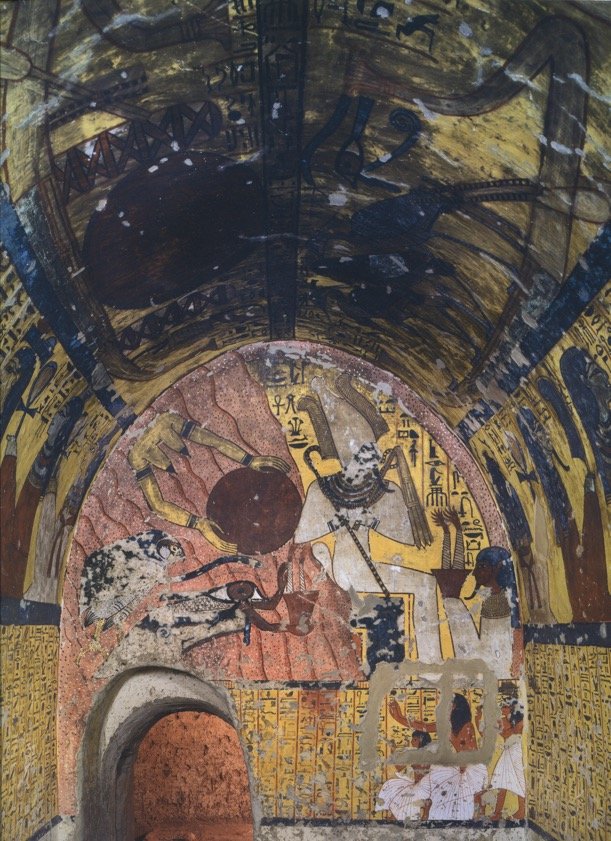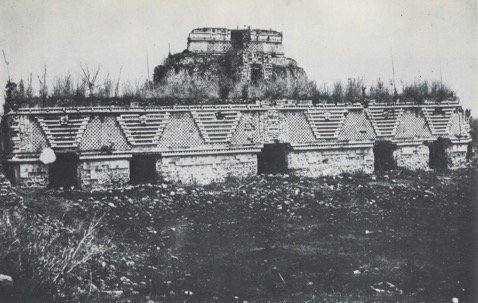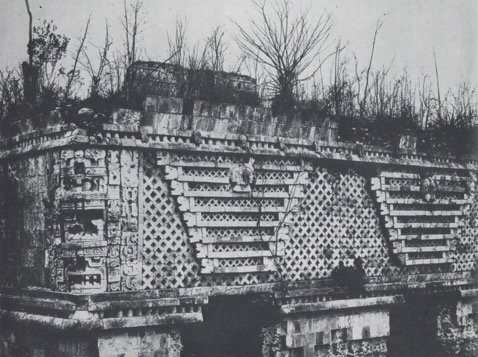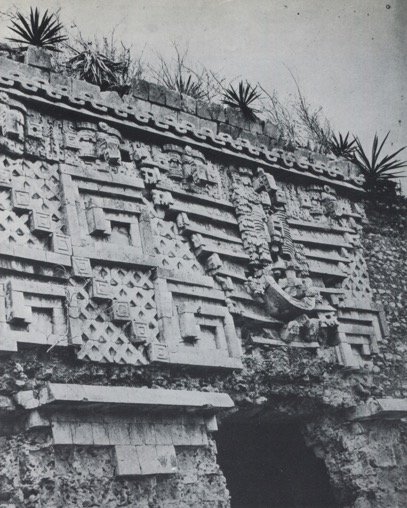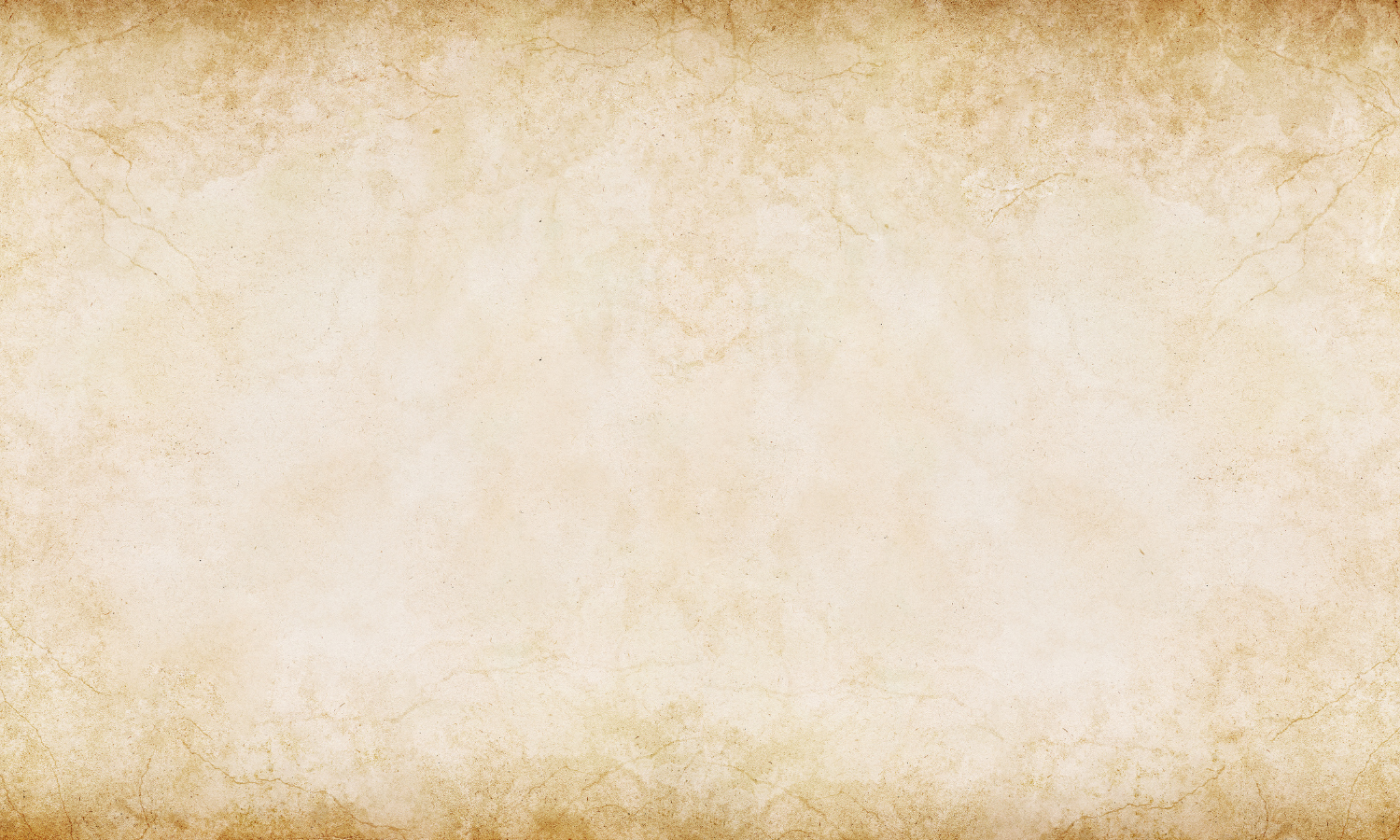
ART MOTIFS
40-54
Fig. 40 Wall Panel c.700 CE Tonina
Fig. 41 Maya Vase c.650 CE?
Fig. 40 Wall Panel c.700 CE Tonina
This vertical net motif is very similar to the paired-squares of the ceremonial bar held horizontally seen in Fig.39. Instead of the two squares this motif has the diamond shape ‘above’ the square shape ‘below’ together suggesting something akin to the Olmec Bucket motif and the measuring of time in the heaven’s above and the measuring of space below on the planet’s surface. The ‘t’-like vertical and horizontal elements, similar to the Christian Vernal Equinox cross likely represent the day before, the day of, and the day after the Vernal Equinox when the zenith sun returning from the Winter Solstice in the southern hemisphere approaches the equator just before crossing over and returning to the northern hemisphere. The three spheres in the three horizontal bands seem to support this idea.
Fig. 41 Maya Vase c.650 CE?
The feathered serpent narrative depicted here likely encodes earth’s celestial mechanics at dawn on the Vernal Equinox. Compare the staff and the zigzagging stacked vertical-square motifs with the vertical net motif seen on the wall panel in Fig.40. The staff is earth’s polar axis and the zigzagging stacked vertical squares likely symbolize earth’s celestial mechanics alternating between rotation and tilt as the sun ‘returns’ from the Winter Solstice. At the left is a horn blown horizontally that has vertical bar-type motifs for both the mouthpiece and the ‘bell’. It is decorated with the earth rotation dominant kin-cross type motif while the woman at the right wields something axe-like at the axial-tilt angle. The headband of the feathered headdress is shown also slanted in the symbolic axial-tilt angle with the feathers held in place by a long straight line with outward facing hooks at either end representing the solstices and a concentric circle in between them just emerging from below the ‘horizon’, the equinox dawn. The tips of the feathers end with a mix of mostly kin-cross axial-tilt dominant motifs.

Fig. 42 Tutankhamun Pectoral
Fig. 43 Maya Vase K6997
Fig. 42 Tutankhamun Pectoral
Osiris, Ruler of the Underworld, and the Egyptian Feathered Serpent align the Winter Solstice sun. Osiris holds the three-feathered flail in his right hand at the earth rotation angle and the crook in his left hand at the axial tilt angle. The crook rests on the vulture’s lower right wing. The vulture represents earth’s rotation and the serpent represents earth’s tilted polar axis. They are placed on semi-circles or hemispheres encoded with the checkerboard motif possibly alluding to earth’s celestial equator orbiting the sun on the plane of the ecliptic. The two pairs of wings are arranged in what is essentially the same pattern as the Mayan vertical-square net motif. (Also see Isis Fig.25.) The wings are arranged in alternating or complimentary pairs, earth rotation and tilt. The vulture’s upper left wing shown at the axial tilt angle is paired with the serpent’s upper right wing at earth’s rotation angle. Their lower wings are similarly paired. The vulture’s lower right wing at the earth rotation angle that Osiris’s crook rests upon is paired with the serpent’s lower left wing at the axial tilt angle. Each wing has three rows of feathers that very likely symbolize earth’s celestial mechanics, its orbit around the sun, its rotation, and its axial tilt. It is quite possible that the alignment of the Newgrange shaft grave (Fig.3) to the rising sun on the Winter Solstice and this pectoral’s Osiris narrative accompanying Tutankhamun through the afterlife likely share the identical narrative, the end of the old solar year and the birth of the new.
Fig. 43 Maya Vase K6997
This vase displays the two symbols referenced above in Fig.41. The crossed band symbol on the right is essentially the kin-cross glyph that symbolizes the earth’s tilted polar axis while the motif on the left with the band, or bar that slants down from left to right over the other ‘axial tilt’ bar symbolizes earth’s rotation, the celestial equator.

Fig. 44 The kin-cross
Fig. 45 Egyptian Hieroglyph
Fig. 44 The kin-cross
The kin-cross motif shown with the axial-tilt angled bar, or band, passing ‘over’ the celestial equator earth rotation bar.
Fig. 45 Egyptian Hieroglyph
Egyptian glyph possibly encoding the two kin-cross type motifs as equals, though there does appear to be a faint line suggesting an attempt to partially emphasize the kin-cross.

Fig. 46 The Serpent Bird Tikal
Fig. 47 North Face Stela A Quirigua
Fig. 46 The Serpent Bird Tikal
The Serpent Bird carved on this lentil from Tikal shows the kin-cross motif on the left symbolizing earth’s axial tilt, the Serpent, in combination with its ‘twin’ on the right symbolizing earth’s rotation, the Bird. The kin-cross motif is shown here with the overlapping band, or bar, that symbolizes earth’s axial tilt combined with the ‘hook’ motif. This kin-cross-hook motif is quite rare and links the ‘hook’ to earth’s tilted polar axis.
Fig. 47 North Face Stela A Quirigua
The figure here, possibly GII of the Palenque Triad, is shown facing north with his head turned to the left, his right, likely towards the east at dawn on the Vernal Equinox. As the first rays of the equinox dawn sun begin descending from the top of Stela A all three celestial mechanics can be seen in motion and are likely encoded in the narrative carved on the east face of this stela. This puts Stela A in a right angle triangulated relationship with the sun rising due east and the pole star due north. The large kin-cross pectoral above the twin kin-cross motifs displayed together vertically seems to suggest an axial tilt-centric perspective that emphasizes the significance of the axis’ alignment to the plane of the ecliptic on the equinox. The lifting of the foot may represent the earth ‘dance’ that takes place as the orbiting earth rotates on its tilted polar axis into the equinox dawn.

Fig. 48 Mayan Zoomorph Quirigua
Fig. 49 Tripod Vessel c. 250CE Teotihuacan
Fig. 48 Mayan Zoomorph Quirigua
Compare the twin kin-cross motifs on this zoomorph from Quirigua with those on the lentil from Tikal in Fig.46. Does this left right reversal of motifs reflect a slightly different cosmology regarding celestial mechanics between Tikal and Quirigua or merely a different stylistic convention?
Fig. 49 Tripod Vessel c. 250CE Teotihuacan
The vertical-square net motif composed of alternating green and white colored bands showing each of the four possible combinations of one band passing over another suggests the complimentary dual nature of earth’s celestial mechanics, its rotation and its axial tilt. The rounded hook motif suggests an axial tilt-centric perspective or emphasis. In the center of the flower symbol is a green circle with a red center, literally the earth orbiting the sun. The four square hooks pointing in the counterclockwise direction of earth’s orbit around the sun symbolize the four ‘stations of the sun’, the two solstices and the two equinoxes. (Fig.1b) Given the prevalence of the rounded hook motif it is likely that this ceramic is symbolically encoding the role earth’s tilted axis plays in earth’s celestial mechanics, especially on the equinoxes. The real question is how did the artist draw all of the straight lines of the net on the concave surface of this cylindrical object? In any other context this would imply the knowledge of and or use of spherical trigonometry, or at least the ability to be able to symbolically encode the idea without actually knowing any trigonometry. If Hugh Harleston’s thesis is correct, that the knowledge and use of spherical trigonometry was existent at Teotihuacan then this

Fig. 50 Stela M Quirigua
Fig. 51 Egyptian Tomb
Fig. 50 Stela M Quirigua
The interwoven zigzagging ‘mat’ symbols displayed vertically in a similar manner to the serpent staff on the Mayan vase in Fig.41 above suggests a particular encoding or interpretation of the relationship between the earth’s rotation and its tilted polar axis. Something held horizontally along with the two kin-cross motifs just below all together seem to link the identity of this figure to the knowledge of, or particular interpretation of earth’s celestial mechanics very likely on the Vernal Equinox.
Fig. 51 Egyptian Tomb
At the upper left of this image is a boat with a pair of oars slanted at the axial-tilt angle. The tops of the oars touch a row of four kin-cross type motifs also shown slanting at the axial-tilt angle together with the vertical bars or bands that separate them slanted at the opposite celestial equator angle. One of these mimics the kin-cross axial-tilt motif and the other three mimic the earth rotation motif. All together these alternating motifs are likely symbolic shorthand for the Vernal Equinox’s celestial mechanics being encoded into the Osiris afterlife ritual. Though not easy to see, there is a second row of these motifs similarly placed at the end of the tomb. (Compare Osiris’ crook with Fig.42)

Fig. 52 The Nunnery Uxmal
Fig. 53 The Nunnery Uxmal
Fig.52 The Nunnery Uxmal
The Nunnery decorated with the vertical-square net motif is in the foreground with the Temple of the Magician behind decorated with a net pattern that appears to be more of a diamond-net than the vertical-square net possibly because it is an astronomical observatory and the diamond net implies the measuring of time. The Temple of the Magician is not aligned due east, but south of east, suggesting an alignment to the location on the eastern horizon of the rising sun at dawn on either the Winter Solstice or on the zenith passage. Zenith passages can be used to determine latitude. Uxmal is located at approximately latitude 20n, Xibalba’s upper boundary, which also includes Tulum and Chichen Itza to the east and Teotihuacan and Cabo Corrientes on the Pacific coast to the west.(See Pt.II, Xibalba and the Road of the Gods)
Fig.53 The Nunnery Uxmal
Close up of the Nunnery showing the vertical-square net architectural motif made of ‘x’s similar to the kin-cross type motifs. (Fig.54)

Fig. 54 Governor’s Palace Uxmal
Fig.54 Governor’s Palace Uxmal
The Governor’s Palace with vertical square-net architectural motif clearly constructed of ‘x’ shaped carved blocks suggesting two different but similar ways to view the slanted vertical elements that make up the square and the x. Seen here associated with a double square spiral suggests either the earth’s orbit around the sun or its rotation on its axis, possibly encoding both on the equinoxes.
